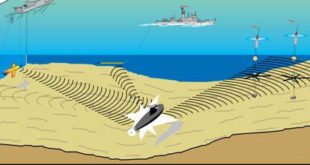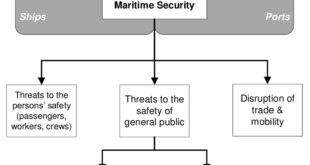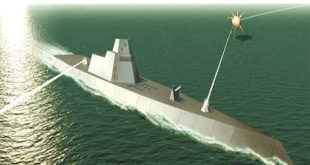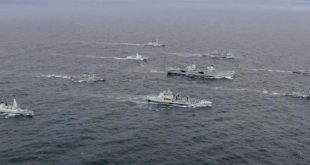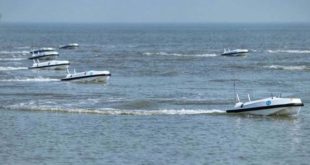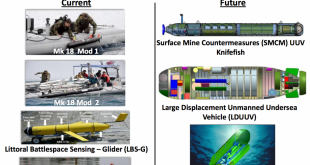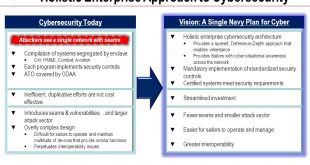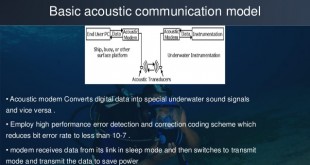Three decades ago, only a handful of major powers had effective submarine capabilities but, today, fleets in operation around the world are growing rapidly. Emerging superpowers, like China, can add naval capacity equivalent to a European country’s in the space of a few years. The threat from submarines is serious …
Read More »Rising Maritime threats require Smart Ports, Ship security and safety technologies to improve security and stability of maritime domain
The oceans are vital to the overall growth of the world economy and population, and to the continued economic integration of nations. The oceans are a primary source of food, energy, and transportation, all key requirements of human activity in an interconnected world. They are also essential to meet the …
Read More »Navies require Automated AUV Launch and Recovery System for a variety of Ships , USVs or submarine platforms
UUVs—submersible unmanned vehicles—are divided into two categories: remotely operated underwater vehicles (ROVs) and autonomous underwater vehicles (AUVs). ROVs are controlled and powered by a person or crew on either land or neighboring craft via an umbilical or using remote control. The truly autonomous AUV systems are typically deployed from a …
Read More »US Navy modernizing it’s C4ISR for implementing it’s Information Superiority Vision
The Department of the Navy Chief Information Officer Aaron Weis has released the DON Information Superiority Vision in Feb 2020 which conveyed the DON’s vision for information superiority through our information, modernized network design, and our workforce; and defines our way forward. As stated by General David H. Berger, the 38th …
Read More »US Navy developing next generation laser weapons for defending warships from ballistic and cruise missiles to Hypersonic Missiles
Navy ships face an increasing number of threats in conducting their missions, including UAVs, armed small boats, and adversary intelligence, surveillance and reconnaissance systems. The US Navy is concerned about the survivability of Navy surface ships in potential combat situations against adversaries, such as China, that are armed with large numbers …
Read More »Amid Rising naval threats from Russia and China enhanced collaboration of Royal Navy and US Navy
Russia and china are asserting their growing military might and reach through seas a threat to NATO nations. Russian naval activity is now at its highest levels since the Cold War. Head of the Russian Navy, Admiral Vladimir Korolev stated that in 2016 their submarine fleet had spent more than …
Read More »DARPA “Sea Train” developing Autonomous swarm of Unmanned Surface Vehicles (USV) for enhancing range of Naval operations
Militaries are becoming increasingly reliant on unmanned ground, sea and aerial vehicles to carry out dull, dirty and dangerous missions. Unmanned Surface Vehicles (USV ) is a vehicle that operates at or near the sea surface and has no vehicle operators on board. The US is investing in the development and …
Read More »US Navy’s new massive attack drones, Large Displacement Unmanned Undersea Vehicle (LDUUV) and Extra Large UUV (XLUUV) for assured access in A2/AD environment
USN has revised its Maritime strategy, for decisive war fighting advantage, in anti-access, area denial environment. US Navy’s vision is to achieve an integrated hybrid force of manned and unmanned systems with the ability to sense, comprehend, predict, communicate, plan, make decisions and take collaborative action to achieve operational goals. …
Read More »Navies developing cyber security measures and cyber defense technologies to counter growing cyber threats
Ships are increasingly using systems that rely on digitization, integration, and automation. Offensive actors understand the naval reliance on communications, ISR, and visualization technologies, and perceive them as vulnerable to disruption and exploitation. In 2016, the Baltic and International Maritime Council (BIMCO) in their “Guidelines on Cyber Security Onboard Ships,” warned about the …
Read More »Underwater Acoustic Wave (UWAC) Communication technologies including Acoustic Modems enable Unmanned Underwater Vehicles (UUWs) missions
Approximately 70% of the Earth’s surface is covered by water, yet almost 95% of the underwater world remains unexplored. Nearly 4000 robots are swimming up and down in the world’s oceans, which allow scientists to measure and understand ocean dynamics, like the directions and speeds of currents, as well as …
Read More » International Defense Security & Technology Your trusted Source for News, Research and Analysis
International Defense Security & Technology Your trusted Source for News, Research and Analysis
